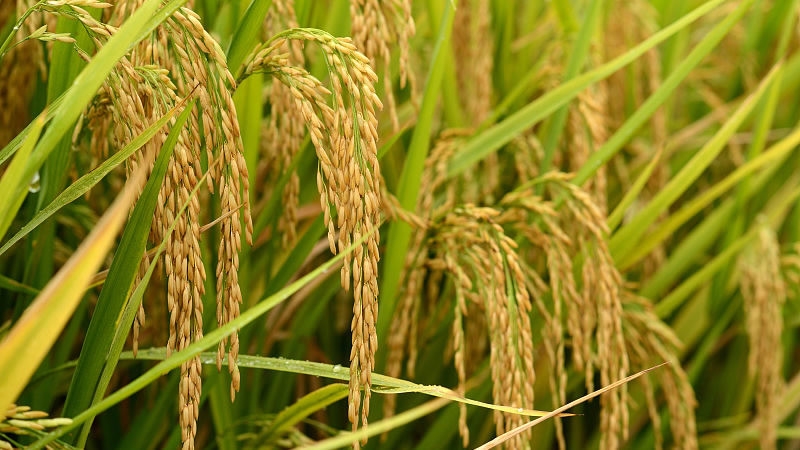Chinese scientists have found a gene which plays an important role in helping rice, originating in warm southern China, expand to the relatively cold northern regions.
иҝ‘ж—ҘпјҢдёӯеӣҪ科еӯҰ家еҸ‘зҺ°дәҶдёҖз§Қеҹәеӣ пјҢе®ғеңЁеё®еҠ©еҸ‘жәҗдәҺжё©жҡ–зҡ„дёӯеӣҪеҚ—ж–№зҡ„ж°ҙзЁ»еҗ‘зӣёеҜ№еҜ’еҶ·зҡ„еҢ—ж–№ең°еҢәжү©еұ•ж–№йқўеҸ‘жҢҘдәҶйҮҚиҰҒдҪңз”ЁгҖӮ
Rice grown in Asia include two subspecies, indica rice and japonica rice. The heat-resistant indica rice is mainly planted in southern China, as well as the tropical and subtropical areas in South Asia and Southeast Asia.
дәҡжҙІз§ҚжӨҚзҡ„ж°ҙзЁ»жңүдёӨз§Қдәҡз§ҚпјҢзұјзЁ»е’ҢзІізЁ»гҖӮиҖҗзғӯзұјзЁ»дё»иҰҒз§ҚжӨҚеңЁдёӯеӣҪеҚ—ж–№д»ҘеҸҠеҚ—дәҡе’ҢдёңеҚ—дәҡзҡ„зғӯеёҰе’ҢдәҡзғӯеёҰең°еҢәгҖӮ
While the japonica rice, after nearly 10,000 years of domestication and selection, can tolerate cold weather and has been expanded to northern China and the temperate zones in Northeast Asia.
иҖҢзІізЁ»зЁ»зұіз»ҸиҝҮиҝ‘10000е№ҙзҡ„еҹ№иӮІе’ҢйҖүжӢ©пјҢеҸҜд»ҘеҝҚеҸ—еҜ’еҶ·зҡ„еӨ©ж°”пјҢе·Із»Ҹжү©еұ•еҲ°дёӯеӣҪеҢ—йғЁе’ҢдёңеҢ—жё©еёҰдәҡжҙІгҖӮ

After analyzing 202 rice samples from various growing regions around the world collected by the Department of Agriculture of the United States, Chinese researchers at the Institute of Genetics and Development Biology of the Chinese Academy of Sciences identified a gene, bZIP73, associated with cold tolerance.
дёӯеӣҪ科еӯҰйҷўйҒ—дј дёҺеҸ‘еұ•з”ҹзү©еӯҰз ”з©¶жүҖзҡ„з ”з©¶дәәе‘ҳеңЁеҲҶжһҗдәҶзҫҺеӣҪеҶңдёҡйғЁж”¶йӣҶзҡ„жқҘиҮӘдё–з•Ңеҗ„ең°дёҚеҗҢз§ҚжӨҚең°еҢәзҡ„202д»Ҫж°ҙзЁ»ж ·е“ҒеҗҺпјҢеҸ‘зҺ°дәҶдёҖз§ҚдёҺиҖҗеҜ’жңүе…ізҡ„еҹәеӣ bZIP73гҖӮ
The researchers believe the gene has facilitated the adaptation of rice to low temperatures.
з ”з©¶дәәе‘ҳи®ӨдёәпјҢиҝҷз§Қеҹәеӣ жңүеҠ©дәҺж°ҙзЁ»йҖӮеә”дҪҺжё©зҺҜеўғгҖӮ
Rice is one of the most important cereal crops feeding more than half of the world's population.
ж°ҙзЁ»жҳҜдё–з•ҢдёҠжңҖйҮҚиҰҒзҡ„и°·зұ»дҪңзү©д№ӢдёҖпјҢе…»жҙ»дәҶе…ЁзҗғдёҖеҚҠд»ҘдёҠзҡ„дәәеҸЈгҖӮ
Cold stress is a major factor limiting production and geographic distribution of rice, said Chu Chengcai, a lead scientist in the research.
иҝҷйЎ№з ”з©¶зҡ„йҰ–еёӯ科еӯҰ家еӮЁжҲҗжүҚиЎЁзӨәпјҢеҶ·еә”еҠӣжҳҜйҷҗеҲ¶ж°ҙзЁ»дә§йҮҸе’Ңең°зҗҶеҲҶеёғзҡ„дёҖдёӘдё»иҰҒеӣ зҙ гҖӮ
The discovery may help breed new rice varieties which can grow in high latitude and high altitude regions, Chu said.
еӮЁжҲҗжүҚз§°пјҢиҝҷдёҖеҸ‘зҺ°еҸҜиғҪжңүеҠ©дәҺеҹ№иӮІж–°зҡ„ж°ҙзЁ»е“Ғз§ҚпјҢиҝҷдәӣж°ҙзЁ»е“Ғз§ҚеҸҜд»ҘеңЁй«ҳзә¬еәҰе’Ңй«ҳжө·жӢ”ең°еҢәз”ҹй•ҝгҖӮ













